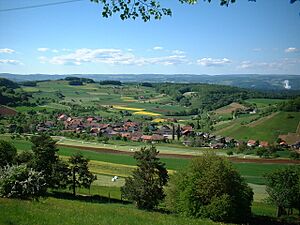Mandach facts for kids
Quick facts for kids
Mandach
|
||
|---|---|---|
 |
||
|
||
| Country | Switzerland | |
| Canton | Aargau | |
| District | Brugg | |
| Area | ||
| • Total | 5.54 km2 (2.14 sq mi) | |
| Elevation | 489 m (1,604 ft) | |
| Population
(Dec 2020 )
|
||
| • Total | 325 | |
| • Density | 58.66/km2 (151.9/sq mi) | |
| Postal code |
5318
|
|
| Surrounded by | Böttstein, Hottwil, Leuggern, Villigen, Wil | |
Mandach is a small town, also called a municipality, in Switzerland. It is located in the canton of Aargau, within the Brugg district.
Contents
Mandach's Past: A Look at Its History
Mandach was first mentioned in old writings in 1218 as Mandacho. Before that, around 1072, a chapel was built nearby by the Lords of Wessenberg.
Important groups like Säckingen Abbey and two Habsburg vassals (who were like loyal helpers to the Habsburg rulers) owned land and castles here. Over time, other noble families, like the Lords of Büttikon and Heudorf, took control.
In 1468, after a big fight called the siege of Waldshut, the Confederates took over Mandach. They added it to their Schenkenberg district.
Mandach faced tough times. A fire destroyed the village in 1518. Later, the plague (a serious illness) hit the village in 1593 and again in 1668. During the Protestant Reformation, the village changed its main religion to Protestantism.
For many years, farming and growing grapes for wine were the main ways people made a living. In 1740, cotton weaving started in the village. Because Mandach was hard to reach, it didn't get many factories during the 1800s. This caused many people to move away. Even in 2000, farming still provided most of the jobs in Mandach.
Where is Mandach? Exploring Its Geography
Mandach covers an area of about 5.55 square kilometers (about 2.14 square miles). A large part of this land, about 67.6%, is used for farming. Forests cover another 26.5% of the area. The remaining 6.3% is where buildings and roads are located.
Most of the forested land is dense forest. For farming, people grow crops, use land for pastures, and have orchards or vineyards.
Mandach is located between two hills, Rotberg and Besseberg. The village itself is a haufendorf. This means it's an old, unplanned village with buildings packed closely together around a central area.
Mandach's Coat of Arms
The official design of Mandach's coat of arms shows a silver background with a black figure on top. Below that, the shield is red.
Who Lives in Mandach? Understanding Its People
Mandach has a population of about 300 people. A small number, about 3.2%, are people from other countries. Over the last ten years, the number of people living in Mandach has changed a little, going down by about 1.9%.
Most people in Mandach, about 98.4%, speak German. A few people speak Serbo-Croatian or Italian.
In 2008, about 12.3% of the population were children aged 0-9. Teenagers aged 10-19 made up about 15.5%. Adults aged 20-59 made up about 53.2% of the population. Older adults, aged 60 and above, made up about 18.7%.
Many homes in Mandach are owned by the people who live in them. The average household has about 2.8 people.
In the 2007 federal election, the most popular political party was the SVP. They received about 61.5% of the votes.
Most people in Mandach are well-educated. About 79.6% of adults (aged 25-64) have finished high school or gone on to higher education like university. In the 2008/2009 school year, 34 students attended primary school in Mandach.
Here's how Mandach's population has changed over time:
| Historical population | ||
|---|---|---|
| Year | Pop. | ±% |
| 1850 | 504 | — |
| 1900 | 361 | −28.4% |
| 1950 | 292 | −19.1% |
| 2000 | 313 | +7.2% |
What to See: Mandach's Sights
The village of Mandach is recognized as an important part of Inventory of Swiss Heritage Sites. This means it has special historical or cultural value that should be protected.
Mandach's Economy: How People Make a Living
In 2007, Mandach had a very low unemployment rate of 0.89%. This means almost everyone who wanted a job had one.
In 2005, most jobs were in the primary economic sector, which includes farming. There were 21 businesses in this area, employing 43 people. The secondary sector (like manufacturing) had 1 business and 2 employees. The tertiary sector (like services) had 9 businesses and 34 employees.
Many people who live in Mandach travel outside the town for work. About 70.6% of residents worked in other places. Only 15 people came into Mandach to work. Most people used a private car to get to work, while a small number used public transportation.
Religion in Mandach
Based on information from 2000, about 16.6% of the people in Mandach were Roman Catholic. A larger group, about 78.3%, belonged to the Swiss Reformed Church.
Images for kids
See also
 In Spanish: Mandach para niños
In Spanish: Mandach para niños











